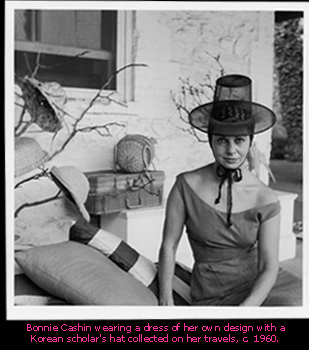
Chic is Where You Find It
“Wouldn’t
it be nice if I could get a tweed by
spinning together a bird’s nest and a
spider’s web?”
—Bonnie Cashin, 1972
Bonnie Cashin (1908-2000) was one of the
foremost American fashion designers in the second half of the
twentieth century. At the vanguard of her field for nearly forty
years, it is impossible to overstate the enormity of her influence
on twentieth-century design. Best known for modular, layered clothes
for Sills and Co. and accessories for Coach, fashion design was
but one medium of expression for a woman whose work and life was
a seamless continuum and madcap adventure.
A "nomad by nature," Cashin grew up in a string of California
cities, particularly fascinated by the jostling of Asian and South
American cultures. She dreamt of being a ballerina, an artist
or a writer. These early passions — for travel, exoticism,
dancing, drawing, and storytelling — combined with her determination
and talent to form a series of creative careers on both American
coasts. She designed costumes for chorus girls, uniforms for World
War II, and wardrobes for over sixty Hollywood movies, before
her decades of fashion work as a "name" on Seventh Avenue.
Cashin's oft-stated credo, "chic is where you find it," sums up
her belief that a "habit of wonder" and an ability to see relationships
between objects and ideas far removed from the fashion world were
the most important tools for a designer. Rather than look at fashion
history, she was apt to cite the "rhythm of poetry or good reading"
from John Gardner, Henry Thoreau, Georges Seferis, Buckminster
Fuller or Bertrand Russell as a means to stretch her mind and
find inspiration for ready-to-wear designs. It is appropriate
that Cashin's archive, a gift from her estate to Special Collections
in the summer of 2003, now resides in a library. It was her hope
that exposure to her whimsical, inimitable approach to design
as a way of life encourage the creative process in any endeavor.
—Stephanie Day Iverson
Curator, Bonnie Cashin Collection
|